Home | Class News | 50th Reunion | Past Reunions | Other Gatherings | Newsletter Archive | Links | Memorials | Classmates Search | Classmates Found | Former Faculty | Contacts |
![]()
Remembering Horton Durfee
Ned Groth, June, 2017
(Author’s note: This remembrance is based on my memories of encounters with Horton, at Darrow and afterwards, and on documents and personal communications, including yearbooks, class newsletters, letters and emails he or Shirley wrote to me, and conversations we had. I have woven in anecdotes from other classmates, other alumni and former faculty. I’ve tried to create an honest and loving portrait of our former master, as we knew him. While I’ve striven for accuracy, I take full responsibility for any errors. This account can be amended, if need to be, as others contribute their own memories to it. –NG)
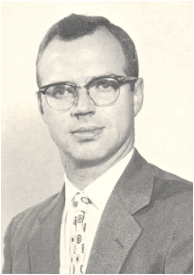 Horton was one of the last remaining anchors to our days at Darrow. Now that he has set sail, after a long life well lived, we here memorialize him as teacher, housemaster and coach for our four years, then as a fellow alumnus, faculty alumnus, and Darrow parent and grandparent for another 55 years.
Horton was one of the last remaining anchors to our days at Darrow. Now that he has set sail, after a long life well lived, we here memorialize him as teacher, housemaster and coach for our four years, then as a fellow alumnus, faculty alumnus, and Darrow parent and grandparent for another 55 years.
When I arrived as a freshman in 1958, Horton was one of the "other faculty" to me. He wasn't my teacher, my coach, housemaster or hands-to-work leader, just part of the adult background. He struck me as on the quiet side, neither flashy nor outspoken, but when he had something to say, he was concise, precise, direct. He was then a bachelor; he had a dog, Brandy, a black lab, was a housemaster in Neale, taught biology and chemistry, and coached lacrosse and JV football. If he had a sense of humor or a temper, I rarely noticed either; he was a low-key guy, who kept such aspects of himself largely under wraps.
Horton, who was born in Geneva, NY on December 30, 1925, was our only faculty member who was a Darrow alumnus (Class of 1943), but he was more likely to mention his connections with Hobart, his college alma mater. He had enrolled at Darrow as a sophomore; several other boys from Geneva were there then, and his parents hoped to improve his math and Latin skills. He was driven up to school with one of the other families, and had never seen the campus until he arrived that fall. He was homesick at first, but adjusted well and soon loved the place.
When we met him, Horton's most distinctive feature was his unusual gait; not a limp, exactly, but he raised and put down one foot rather awkwardly. While that peculiarity made it easy for students to portray him in the faculty-spoof plays we used to have on "talent nights," no one ever made fun of him for it: We knew he had been wounded in Italy during WWII, and respect and admiration far outweighed adolescent impulses to ridicule. If we did make fun of Horton in those spoofs, it involved things like carrying a lacrosse stick in one hand and a textbook in the other. Some kids would mimic his speech, making a "tsk"ing sound through pursed lips and saying, "Quite so, quite so." I honestly never heard Horton say that, but it did sort of sound like him. He was rather prim and proper, but also too nice to pick on. Since we had many teachers then who were more "colorful" (in a variety of good and bad ways), we satisfied our boyish needs to caricature our elders by choosing other targets.
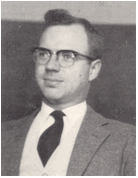
I first encountered Horton in the classroom (which appears to be where this yearbook photo was taken) when I took biology my sophomore year. I can't say for sure—perhaps my future was already preordained—but I really enjoyed the course, and that may have bent my interest toward majoring in biology in college, so I have always felt that Horton did more than most Darrow teachers to set me on my life's path. He taught us at a fairly exciting time in the field. Crick and Watson had published their (Nobel Prize-winning) work on the structure of DNA just a few years before, and researchers were rapidly elucidating how cells function, how DNA codes for life processes, etc. Horton was fascinated by those insights and conveyed that enthusiasm to his students. In addition, our labs were fun. We'd go out to Tanner's Pond or the woods behind the chapel, scoop up a few organisms, then come back and examine them under the microscope. I can still recall my excitement at trivial stuff, like the mouthparts of a dragonfly nymph, the spiral chloroplasts in the alga Spirogyra, or identifying a wildflower by its square stem, the kind of details that fascinate scientists, and by then I guess I was becoming one.
I recall one moment in biology class that Horton handled especially deftly. The state required biology courses to include a unit on "sex education." He presented a pro forma lecture, male and female organs and gametes, see the diagrams in the textbook, etc. etc., "Any questions?" A guy in the class, Dor Watkins '61, a rather indifferent student but a very handsome dude who regarded himself as God's gift to women, had a question, possibly driven by actual curiosity, or perhaps just an attempt to embarrass Horton. Dor asked, "Sir, suppose you're treatin' a girl and the rubber slips, just a little, and a tiny bit of sperm leaks out? Is that OK?" Horton didn't bat an eyelash, he replied calmly and firmly, "It only takes one, Dor, it only takes one." At that point in my life I didn't really need to know that, but Dor might have, and I was impressed with both the soundness of Horton's advice and his cool delivery.
The next year I had Horton for chemistry, a course I also enjoyed. My memories of that class are fairly vague, although I recall several things from our labs. Horton was casual enough about leaving us alone in the lab now and then (perhaps so he could go across the hall to monitor the kids in bio lab), that Gene Cook and I were able to smuggle out a test tube of phenolphthalein solution (see Cook memorial) and John Prentiss was able to fill a condom with hydrogen sulfide and sneak out with it (see Prentiss memorial). Both substances were later put to nefarious uses by those who swiped them (as recounted in those memorials), but we can hardly blame Horton for that. His faith that we'd comport ourselves maturely was simply misplaced.
Horton was also well known on campus as the lacrosse coach. Darrow had not had a lacrosse team until Horton joined the faculty in 1954; he established the sport then. By the time we arrived on campus four years later, the squad had matured. Most of the varsity football team played lacrosse in the spring, and goalie Stafford Keegin '60 was a high-school All-American. Not many schools as small as Darrow played lacrosse, so the schedule included far deeper, stronger teams from Marvelwood and Trinity-Pawling and freshman college squads from Williams and Union. Many games ended with lopsided losses. The 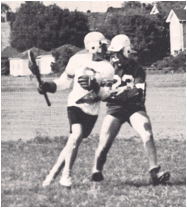
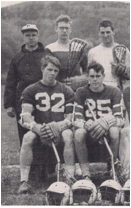 best record in our four years was 3-2-1, and one year the ratio of goals against to goals for was 50-9, but the team played with spirit and, as the saying goes, built a lot of character. Horton also coached the JV football team (now and then, it was a duty that seemed to rotate), and those who played for him on that squad recall him as an able and compassionate coach, but anyone could attest that lacrosse was his first love.
best record in our four years was 3-2-1, and one year the ratio of goals against to goals for was 50-9, but the team played with spirit and, as the saying goes, built a lot of character. Horton also coached the JV football team (now and then, it was a duty that seemed to rotate), and those who played for him on that squad recall him as an able and compassionate coach, but anyone could attest that lacrosse was his first love.
Between our sophomore and junior years, in June 1960, Horton's life changed in a big way: He married Jean Blaney Feidner, who had been teaching at Hobart and William Smith. When Jean arrived at Darrow, Horton also gained a daughter, Linda, who quickly became a friendly young presence around the campus. Jean had a PhD in mathematics, tutored the occasional student who needed it and (Carl Sharpe recalls) sometimes also taught in the classroom. They lived in Ann Lee. In August of 1961, their first son, David, was born.
Once we had "been graduated" and departed the campus, we'd see Horton only when we came back for alumni events. Like us, Horton went on with his life. His and Jean's family grew, as Linda gained two more brothers, Stephen and Paul. Their faculty apartment in Ann Lee quickly became too small. When a new housing development appeared across Route 20, just up the mountainside from the school, they built themselves an off-campus home, moving in during the summer of 1963. They were only 5 minutes from Wickersham and had a lovely view of the campus, but had plenty of space and no more dorm duties.
When I started writing the Class Newsletter in 1968, I got a letter from Horton. He claimed to be a lousy correspondent—"too lazy," he said—but provided the family news just recounted. He also shared his excitement about the new Science Building, then nearing completion.
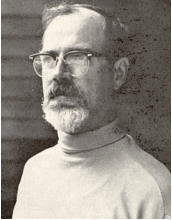 That was actually the only letter Horton himself supplied over the 15 years that our newsletters existed, but he and Jean made fairly frequent appearances, via word passed on from Des McCracken, Don and Marie Sutherland and others. We also caught up with Horton and Jean at our 10th reunion, in the rain, in 1972. And occasionally he appeared in the Peg Board. This portrait, from the Peg Board in 1973, is our only record of Horton with facial hair—possibly a reddish beard, it's hard to tell from the b & w photo. He, Des McCracken and Walt Lehmann were featured in a column by John Joline honoring his longest-serving faculty. At that point Horton was in his 19th year at Darrow; he had added an environmental science course to the curriculum, and was still coaching lacrosse. That article spoke of Horton's regular attendance at the reunions of his WWII combat unit (the famed 10th Mountain Division) in Colorado, and noted that he was then the only faculty member who had a daughter who was also an alumna; Linda had been graduated in 1972 (she was the valedictorian) and was then at Bowdoin.
That was actually the only letter Horton himself supplied over the 15 years that our newsletters existed, but he and Jean made fairly frequent appearances, via word passed on from Des McCracken, Don and Marie Sutherland and others. We also caught up with Horton and Jean at our 10th reunion, in the rain, in 1972. And occasionally he appeared in the Peg Board. This portrait, from the Peg Board in 1973, is our only record of Horton with facial hair—possibly a reddish beard, it's hard to tell from the b & w photo. He, Des McCracken and Walt Lehmann were featured in a column by John Joline honoring his longest-serving faculty. At that point Horton was in his 19th year at Darrow; he had added an environmental science course to the curriculum, and was still coaching lacrosse. That article spoke of Horton's regular attendance at the reunions of his WWII combat unit (the famed 10th Mountain Division) in Colorado, and noted that he was then the only faculty member who had a daughter who was also an alumna; Linda had been graduated in 1972 (she was the valedictorian) and was then at Bowdoin.
Horton's long tenure at Darrow came to an end in June 1974. I never asked him, nor did he volunteer, to explain why he left, or why then. John Joline had announced that the next year would be his last, and Dave Miller was slated to become head. Des McCracken told me that Horton had chosen himself not to return, and speculated that he was feeling undervalued—he had been left out of several key activities, like a committee preparing the school for a periodic accreditation review by the independent schools association. Des opined that Horton had not kept up with changing times, citing his style of coaching lacrosse (same as it always was, Des observed), which had led to defections from the team and his eventual replacement as coach by a younger Darrow alumnus the prior spring – something Des was sure had hurt. Des saw friction between Horton and some younger faculty (perhaps including Miller), complaints that he was humorless, rigid, unimaginative. Whether those perceptions were justified or not, the situation must have been uncomfortable, and may have persuaded Horton that it was simply time to move on.
When Horton left Darrow, his plans were not really clear. The next couple of class newsletters provided a few more tidbits of second-hand information. In 1975 Des told us that the Durfees continued to live in their house just above the campus, and Horton retained a role as advisor to the model railroad club (a lifelong hobby of his). By summer of 1976, with the boys now all in school, both Jean (hired to teach math), and Horton (filling in for a science teacher on sabbatical) were going to be on the Emma Willard faculty that fall, commuting daily to Troy. Linda, meanwhile, had (been) graduated with honors from Bowdoin.
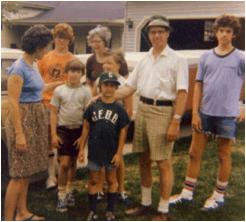 Numerous other Durfee sightings by other former faculty came in ensuing years. The photo here was taken in 1977 by Don Sutherland when the Durfees stopped in Illinois en route to Colorado; Don & Marie's Mark and Janet (center) are mixed in with the Durfee boys. A famous anecdote arose from a visit by the Nunleys to the Durfees in Geneva one summer that subsequently connected Ron Emery with the head of the English Department at Hobart, who at that moment needed to hire someone to teach drama (see Emery memorial.)
Numerous other Durfee sightings by other former faculty came in ensuing years. The photo here was taken in 1977 by Don Sutherland when the Durfees stopped in Illinois en route to Colorado; Don & Marie's Mark and Janet (center) are mixed in with the Durfee boys. A famous anecdote arose from a visit by the Nunleys to the Durfees in Geneva one summer that subsequently connected Ron Emery with the head of the English Department at Hobart, who at that moment needed to hire someone to teach drama (see Emery memorial.)
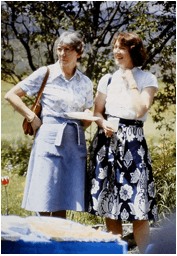 Jean continued to teach at Emma Willard, while by 1979 Horton had moved over to BCC. They still lived just off the Darrow campus, and were usually around on alumni day. The picture of Horton in the hat was taken at our 20th reunion in 1982; the one of Jean and Linda dates from a couple of years before that, I believe. Although I don't remember any lengthy conversations I had with Horton on those occasions (and indeed, such were not really his style), the information we did exchange persuaded me that Horton and Jean were quite content in general and comfortable with their status as faculty alumni.
Jean continued to teach at Emma Willard, while by 1979 Horton had moved over to BCC. They still lived just off the Darrow campus, and were usually around on alumni day. The picture of Horton in the hat was taken at our 20th reunion in 1982; the one of Jean and Linda dates from a couple of years before that, I believe. Although I don't remember any lengthy conversations I had with Horton on those occasions (and indeed, such were not really his style), the information we did exchange persuaded me that Horton and Jean were quite content in general and comfortable with their status as faculty alumni.
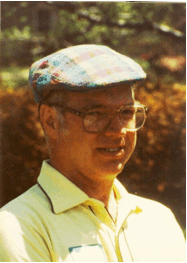 One never stops being an alum, of course, and as more years slip by, one's status grows ever more distinguished. As he expanded his resume, Horton eventually became the only alumnus who was also a faculty member, then past faculty, parent, grandparent (class of '99), and parent of a faculty member (Stephen taught at Darrow from 1985 to '87).
One never stops being an alum, of course, and as more years slip by, one's status grows ever more distinguished. As he expanded his resume, Horton eventually became the only alumnus who was also a faculty member, then past faculty, parent, grandparent (class of '99), and parent of a faculty member (Stephen taught at Darrow from 1985 to '87).
The years went by and we saw Horton every five years or so, at our reunions. He was there to honor Charles Brodhead, when the school did that one year. These Peg Board photos show Horton participating in Alumni Hands-to-Work (1983), at his own 50th reunion (1993), and with Dick and Sue Nunley and John and Margie Joline (in 1999 or 2000).
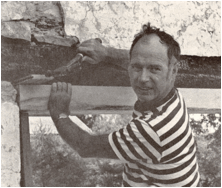
Close observers will note that in that latter photo, Horton's spouse is Shirley, not Jean. In October 1988, Jean was killed in an accident en route to Emma Willard; with no warning at all Horton was widowed. As much as the news stunned us, its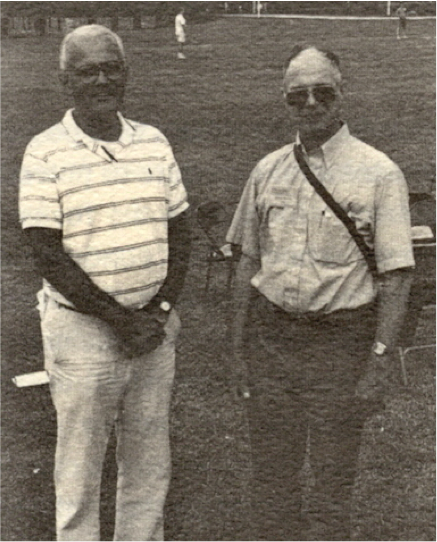 impact on Horton and their children must have been unimaginably painful. But there is also a touch of romantic resonance in that photo. A decade later, in 1998, John Joline lost his Jean, to colon cancer. But shortly afterward he re-encountered Margie Baird; they had known each other since their college days. Her husband had also recently died, and before the year was out they had married. Horton had experienced much the same kind of rebirth after his loss. Not terribly long after Jean's death, he had married Shirley Morgan Kiepper. They had all known each other at Emma Willard, where Shirley taught and worked in Admissions. Thus, over his lifespan Horton shared 55 years, in two almost equal spans, with two strong, caring women. Any of us would hope to be so lucky.
impact on Horton and their children must have been unimaginably painful. But there is also a touch of romantic resonance in that photo. A decade later, in 1998, John Joline lost his Jean, to colon cancer. But shortly afterward he re-encountered Margie Baird; they had known each other since their college days. Her husband had also recently died, and before the year was out they had married. Horton had experienced much the same kind of rebirth after his loss. Not terribly long after Jean's death, he had married Shirley Morgan Kiepper. They had all known each other at Emma Willard, where Shirley taught and worked in Admissions. Thus, over his lifespan Horton shared 55 years, in two almost equal spans, with two strong, caring women. Any of us would hope to be so lucky.

Horton was around at our 40th, 45th and 50th reunions, and the last time we saw him was in 2013. That was his 70th (he was the only attendee) and the school, not for the first time I think, honored him for his many contributions over the decades. Nancy Wolf presented him with a special "lifetime achievement trophy," a vintage lacrosse stick, to which they had affixed a plaque (photo). Horton was deeply touched, although as usual he maintained his low-key demeanor. At that point he was 87, and was not walking very well; the school supplied a golf cart to help him get around. Shirley told us then that that would probably be the last time Horton came to reunions, since his ability to locomote was declining. He was still as sharp as ever, mentally, and some of us (myself included) thanked him then him for his role in our young lives. I gave him some credit for my career path, and he was grateful to hear that. While we didn't exactly feel we were saying final "goodbyes," most of us sensed that if we were going to see Horton again, it would probably be when we passed through Ithaca, not on the campus any more.
I never made it to Ithaca; I'm not sure whether anyone else did. Horton/Shirley remained on my class email list, and she got and sent periodic updates and news. In the last few years they had moved to an assisted living community, which suited their needs. Horton had a mild stroke a couple of years ago, from which he had gradually recovered, but his ability to travel was further limited, and Shirley had to remind us gently that they would not be attending our 55th.
As it turned out, the Reaper had other plans in any case, and came for Horton on May 20th. He died peacefully, surrounded by his family. A memorial service was held in Ithaca on July 6, and Terry Duvall attended, representing our class. As the tributes came in reflecting his long life of service, they very much fit the man: A few well chosen words, minimal fuss. "He was a good guy." "Only fond memories, in the classroom and on the field." "A great teacher and a real human being." "He was always gracious and helpful to me." And from Shirley, "It's a very sad and lonely time, but I'll soldier on, just as Horton always did."
Quite so. Of course we will miss him, and there's another hole in our Darrow fabric that won't be filled. But what a long, good life he had, and how grateful we all are for the many ways in which he touched our own lives and made them better.

Home | Class News | 50th Reunion | Past Reunions | Other Gatherings | Newsletter Archive | Links | Memorials | Classmates Search | Classmates Found | Former Faculty | Contacts |